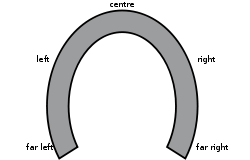Horseshoe theory

The horseshoe theory in political science asserts that rather than the far left and the far right being at opposite and opposing ends of a linear political continuum, they in fact closely resemble one another, much like the ends of a horseshoe. The theory is attributed to French writer Jean-Pierre Faye.[1]
In University of Reading academic Peter Barker's[2] book, GDR and Its History, Peter Thompson[3] of the University of Sheffield observes that the theory is "increasingly orthodox," and describes the theory as seeing "left and right-wing parties being closer to each other than the centre."
Origin of the term
The earliest use of the term in political theory appears to be from Jean-Pierre Faye's book Le Siècle des idéologies.[4] Others have attributed the theory as having come from Lipset, Bell and the ‘pluralist school’.[5]
Modern uses
In 2006 the term was used when comparing a resurgent hostility towards Jews from both the far left and the far right.[6]
In an essay Josef Joffe, of Roland Berger Strategy Consultants, one of the largest strategy consultancies in the world, wrote
Will globalization survive the gloom? The creeping revolt against globalization actually preceded the Crash of '08. Everywhere in the West, populism began to show its angry face at mid-decade. The two most dramatic instances were Germany and Austria, where populist parties scored big with a message of isolationism, protectionism and redistribution. In Germany, it was left-wing populism ("Die Linke"); in Austria it was a bunch of right-wing parties that garnered almost 30% in the 2008 election. Left and right together illustrated once more the "horseshoe" theory of modern politics: As the iron is bent backward, the two extremes almost touch.—Josef Joffe[7]
Explanation of the theory
Horseshoe theory competes with the conventional linear left-right continuum system as well as the various multidimensional systems. Proponents of the theory point to similarities between the extreme left and the extreme right. Specifically, the two ends share an authoritarian element and a desire to greatly increase the size of government in order to advance their respective objectives.
In some far-left political systems (such as state socialism) the government seizes control of all means of production in order to enforce its economic ideology. The government will also push its views onto social policy to better shape the society it controls. In some far-right political systems the government also seizes absolute control of economic activity, seeking to advance the national interest. Much like its counterpart on the left, it also pushes its views onto social programs to shape society into its worldview. This theory asserts that both the far-left and the far-right seek to greatly expand the size and scope of government and are opposed to free and fair elections, free speech, free press, free expression and democratic institutions.
Examples
Assertions have been made that North Korea is a far-right state, in addition to, or perhaps instead of, being a far-left state.[8] In The Cleanest Race, Brian Myers purports that North Korea is far-right due to their xenophobia, intense nationalism and pseudo-religious glorification of former and current leaders and race-based rhetoric, despite the fact that the North Korean regime describes itself as a champion of communism and Marxism-Leninism through its state ideology of Juche.[9] This comparison may suggest, according to some proponents of the horseshoe theory, that supposedly "far-right" policies (jingoism, nationalism, religious rhetoric, etc.) and supposedly "far-left" policies (forceful redistribution of wealth, nationalization of the means of production, class warfare, etc.) are actually located on the same part of the political spectrum.
See also
- Left-right politics
- Political spectrum
- Blair's Law
References
- ↑ Encel, Frédéric; Thual, François (2004-11-13). "United States-Israel: A friendship that needs to be demystified". Le Figaro (Paris). Archived from the original on 2007-09-30. Retrieved 2009-02-13.
Jean-Pierre Faye's famous horseshoe theory (according to which extremes meet) finds verification here more than in other places, and the two states of delirium often mingle and meet, unfortunately spreading beyond these extremist circles. But contrary to the legend deliberately maintained and/or the commonplace believed in good faith, Israel and the United States have not always been allies; on several occasions their relations have even been strained.
- ↑ University of Reading: Peter Barker
- ↑ University of Sheffield: Peter Thompson
- ↑ "Le Siècle des idéologies". Pocket. 2008-12-22.
- ↑ "Challenging Centrist/Extremist Theory". Publiceye.org. 2008.
- ↑ Fleischer, Tzvi (31 October 2006). "The Political Horseshoe again". Australia/Israel Review (AIJAC). Archived from the original on 16 May 2011. Retrieved 27 March 2015.
I think Mr. Loewenstein has done a good job demonstrating why many people believe, as the "political horseshoe" theory states, that there is a lot more common ground between the far left, where Loewenstein dwells politically, and the far right views of someone like Betty Luks than people on the left would care to admit.
- ↑ "New Year's Essay 2009". Roland Berger Strategy Consultants. 2008-12-22.
- ↑ http://mises.ca/posts/articles/north-korea-a-fascist-state/
- ↑ http://www.nytimes.com/2010/01/28/books/excerpt-cleanest-race.html?pagewanted=all&_r=0